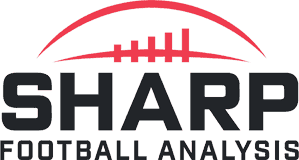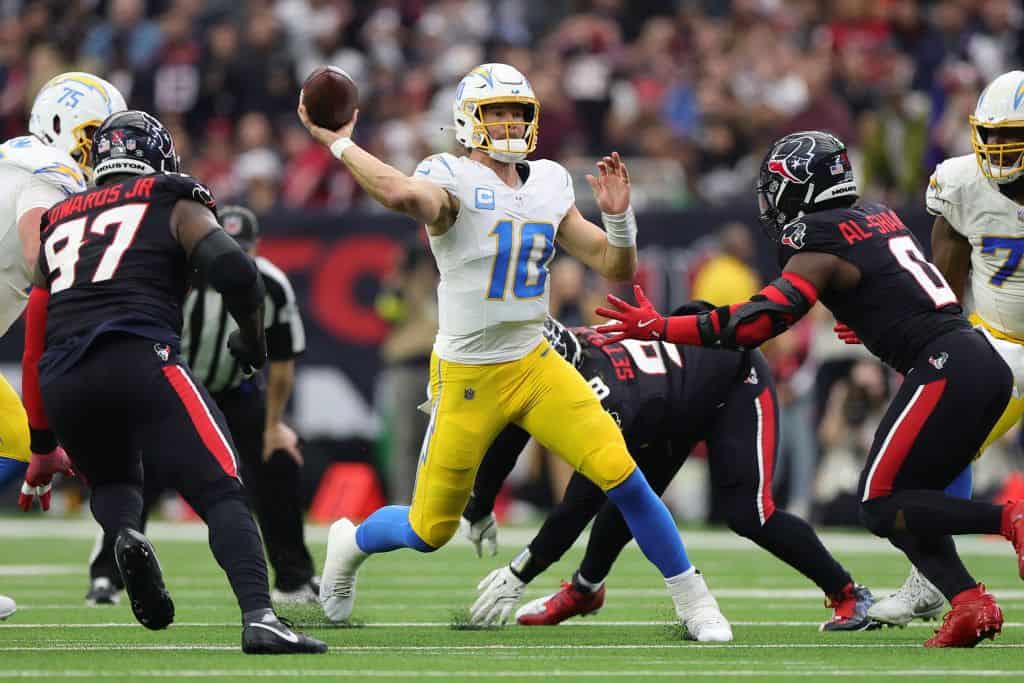What if I told you the Chargers had the second-best record in the NFL last year…if games ended after the third quarter?
Seriously — they were 12-3-2 entering the fourth quarter of games.
Only the Lions were better. The Chiefs, Bills, even the Super Bowl champion Eagles? Worse than the Chargers.
And yet, the Chargers still finished just 11-6. Why? Because no team collapsed harder when it mattered most.
Justin Herbert and this team had double-digit leads, halftime cushions, third-quarter momentum…and let it all slip away. Again.
But 2025 brings a new challenge. Because last year’s 11-win season?
It was real — but it was also misleading.
Herbert’s fourth quarter performance must improve if the Chargers want to win more games.
In one-score games, his numbers cratered.
Of 29 qualifying quarterbacks in the fourth quarter of close games, Herbert ranked:
- 25th in accuracy
- 25th in success rate
- 17th in yards per attempt
- 17th in EPA per pass
This isn’t just bad luck. These are bad results tied directly to Herbert’s own play.
He’s now 6-13 in games decided by a field goal over the last four years — the second-worst record in the league.
If Herbert is going to reach elite status, that has to change.
Because the Chargers won’t get over the hump until their quarterback can carry them in crunch time.
It wasn’t all doom and gloom.
Because in 2024, the Chargers finally had real coaching.
Greg Roman, often branded as a run-heavy dinosaur, came out throwing.
The Chargers ranked top seven in early-down pass rate in the first half.
They attacked through the air, and they did it with play action, using the third-highest rate in the league.
And the difference in Herbert’s performance was night and day:
With play action:
- #7 in success rate
- #5 in accuracy
- #8 in yards per attempt
- #13 in EPA
Without play action:
- #20 in success rate
- #26 in accuracy
- #23 in yards per attempt
Roman’s system raised the floor. The Chargers’ first-half offense ranked:
- #11 in yards per play
- #11 in success rate
- #12 in EPA per play
That’s a massive jump from their 2023 numbers, which were in the low 20s across the board.
They built leads. They led at halftime more than almost anyone. And that gave them a real identity for the first time in years.
But let’s not ignore what helped them pad that win total — a cupcake schedule of quarterbacks.
Last year, the Chargers faced:
- Gardner Minshew
- Bryce Young
- Justin Fields
- Bo Nix (twice)
- Jameis Winston
- Will Levis
- Jake Haener
- Drake Maye
- Aidan O’Connell
Twelve of their 17 games came against backups, rookies, or benched quarterbacks.
Against decent quarterbacks — guys like Patrick Mahomes, Joe Burrow, Lamar Jackson, and Baker Mayfield — they went 1-5.
And in those games, their defense looked like one of the worst in the NFL:
- 101 passer rating allowed
- 12 touchdowns, 3 interceptions
- +0.13 EPA per pass
But against the backups? They looked elite:
- -0.14 EPA per pass
- 12 touchdowns, 12 interceptions
- 80 passer rating
It was a total mirage — a defense that dominated bad QBs but melted against anyone competent.
And now? That’s over.
In 2025, the Chargers are projected to face:
- The NFL’s toughest schedule of pass defenses
- The third-toughest schedule of run defenses
- And a much stronger slate of opposing quarterbacks
That’s a recipe for regression if the run game doesn’t take a major step forward.
Because here’s the real issue — the Chargers were awful running the ball last year.
Even with a top 10 offensive line that was a healthy unit all season, they ranked:
- 29th in success rate on early down runs
- 29th in yards per carry
- 28th in stuff rate
- 30th in explosive run rate
- 25th in yards before contact
It didn’t matter if they ran with three wide receivers or out of heavy formations — it wasn’t working.
Enter Omarion Hampton — the rookie workhorse with burst and contact balance.
He led North Carolina’s offense last year, accounting for 44% of touches and 39% of total yardage.
He’s explosive, he’s built for three downs, and he might be the most important piece of this offense in 2025.
Because if the Chargers want to hold leads — a big problem last year — they need balance.
They need a reliable run game. And they need Herbert to step up in the moments that matter most.
So here’s the bottom line:
The 2024 Chargers were better coached, more aggressive early, and way more competent overall.
But they were also propped up by a soft schedule and collapsed in big moments.
2025 will demand more. Tougher defenses. Better quarterbacks. Higher expectations.
And if they don’t improve in the red zone, on the ground, and in the fourth quarter, we’ll be right back here in January, wondering how a top 10 team managed to underachieve again.
The good news? The foundation is solid.
The bad news? The schedule is harder, and expectations are higher.
Get a full breakdown of the Los Angeles Chargers and every other NFL team in Warren Sharp's 2025 Football Preview!
Warren Sharp’s 550+ page full-color PDF, the 2025 Football Preview, is unlike anything you have previously read. Stunning visualizations, including new heat maps, are built with the reader in mind. Innovative, next-level thought process abounds in every team chapter and article.
Get Warren's Book for $34.99
Warren Sharp's book shares insights into the players, coaches, teams, and philosophies with one goal: to prepare you for the 2025 NFL season with the smartest information delivered in the fastest, most direct way possible for optimal reviewing and retention.
- Team Chapters previews are in-depth, data driven & full of actionable info
- Fantasy Football player profiles, predictions, and ranks
- Vegas Odds forecast team wins, division rankings, lines for all 2025 games
- Coaching strategic advice for teams, play calling analysis & team tendencies
- Front Office Analysis positional spending, roster construction & cap analysis
- Reasons to bet over/under win totals & analysis of futures betting market
- Rookie draft class deep dive into impact for every team
- Rankings for every positional unit on every team with analysis

















